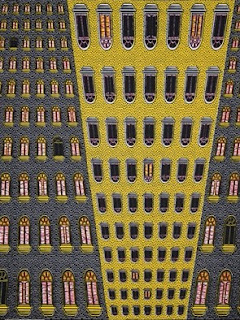 |
| Vlisco |
The wax paradox: what could be more typically African than wax print fabrics made and designed for over 150 years in Holland or England? How is it possible that Africa, a country so rich in diverse textile traditions, has so strongly identified itself and been identified by other nations with these imported textiles? The wax prints we know today started out as mass-produced imitations of Javanese batiks in the beginning of the 19th century which ended up with West Africa as its strongest market.
 |
| Vlisco |
Anne Grosfilley is an anthropologist whose thoughtful and informative book, Afrique des Textiles offers many insights on the subject as well as covering the whys and hows of locally made African textiles today. She explains, "An understanding of wax fabrics leads to the discovery of how a fabric from abroad, from Europe in this case, became an essential element in the west African textile landscape. It also means recognizing how the history of relations between Europe and Africa has been recorded through fabric since the colonial period. Long before wax prints became identified with Africa, they were cloths of otherness, a white person's view of black populations, a Westerner's projection on the African world."
 |
| Vlisco |
Once distributed in West Africa today, these prints fall into the hands of the mostly female wholesalers who give each fabric a name to truly adapt it to local clientele. The right name can multiply the article's price up to 5 times, if the demand is strong enough. Anne Grosfilley says that relating a fabric to a political or television celebrity is a means of identification and cites a design with small ovals which was given the name "Z'ongles de Madame Thérèse" ( Mme Therese's nails), named for the then Ivorian president Boigny's wife. A rumor at the time had spread that the president had a mistress and that Mme Boigny would surely claw her face if she caught her. Wearing this fabric became a way of showing oneself to be a strong woman who was not submissive to her husband. The economic re-appropriation of these goods is no longer just a means to enriching certain women, but has become a social phenomena.
This recent design is named Michele's handbag.
 |
| Burberry Prorsum resort 2012 via IBTimes |
These past few years, European high fashion has also adopted these prints with all their colorful creativity. I recently spotted Franck Sorbier buying a roll of geometric wax prints,
 |
| Vlisco |
The manufacturer of the most appreciated by the African diaspora today is the prestigious Vlisco, whose site is always a joy to visit. The numerous designs take you into a world of unbridled fantasy that tend to make everything else feel humdrum. If you are not familiar with them, take a look at the great variety of designs and remember that their scale...
 |
| Vlisco |
is often much larger than you may realize.
 |
| Vlisco |
 |
| Vlisco |


i don't really get how they are made....
ReplyDeletebut how beautiful they are!!!
xx
Ah! So sorry, I'll explain in another post.
ReplyDelete